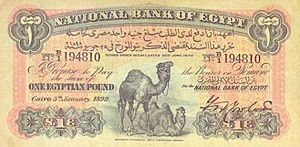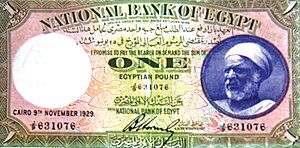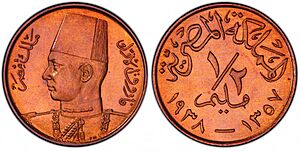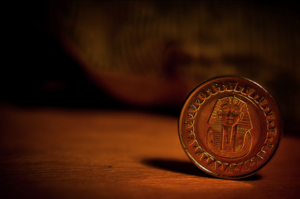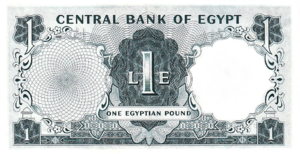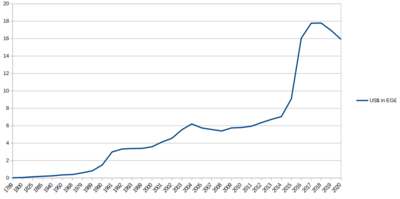Egyptian pound facts for kids
Quick facts for kids Egyptian pound |
|
|---|---|
| ISO 4217 Code | EGP |
| Official user(s) | |
| Unofficial user(s) | |
| Inflation | 27.130% (2024) |
| Subunit | |
| 1⁄100 | Piastre (قرش, "qirsh") |
| 1⁄1,000 | Millieme (مليم, mallīm) Milliemes are obsolete. |
| Symbol | £, E£, £E, LE, EGP, .ج.م |
| Coins | 25 PT, 50 PT, £1 |
| Banknotes | |
| Freq. used | £5, £10, £20, £50, £100, £200 |
| Rarely used | 25 PT, 50 PT, £1 |
The Egyptian pound (also called EGP) is the official money used in Egypt. It's often shown with symbols like £, E£, or LE.
One Egyptian pound is made up of 100 smaller units called piastres. In the past, it was also divided into 1,000 milliemes, but these are not used anymore. Since July 6, 2022, some banknotes, like the 10 and 20 pound notes, are made from a special plastic material called polymer.
Contents
History of Egyptian Money
How the Egyptian Pound Began
At the start of the 1800s, Egypt and Turkey used the same money, called the Ottoman piastre. But under Muhammad Ali of Egypt, Egypt started making its own coins. In 1834, Egypt officially created its own money system.
This new system used both silver and gold coins. A popular silver coin called the Maria Theresa thaler was worth 20 piastres. Egypt also made a gold coin called the bedidlik, which was worth 100 piastres.
The Pound Becomes Official
Even though people sometimes called 100 Egyptian piastres a "pound," it wasn't the main unit of money at first. The idea of an Egyptian pound as an official unit appeared in 1884. It became the official currency unit in 1885.
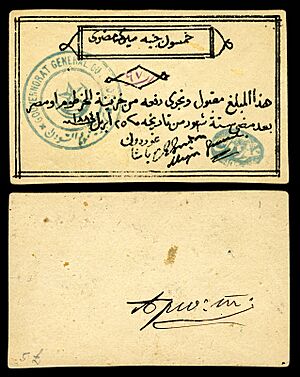
In 1885, Egypt decided to use only gold to back its money, a system called the gold standard. The Egyptian pound was set to be worth 7.4375 grams of pure gold. This was done to keep its value similar to the British gold sovereign. The piastre then became worth 1/100th of a pound.
Changes Over Time
Banknotes with the word "pounds" on them first appeared in 1899. During World War I, the Egyptian pound was linked to the British pound sterling. One Egyptian pound was worth one pound and sixpence sterling. This link continued until the early 1960s.
After that, Egypt changed its money system. The Egyptian pound was then linked to the United States dollar, with E£1 being worth US$2.3. The Egyptian pound was also used in other places like Anglo-Egyptian Sudan and Mandatory Palestine for some time.
Names for Money
Old and Informal Names
People in Egypt have used many unofficial names for different amounts of money. For example:
- Nekla (نكلة) was used for 2 milliemes.
- Ta'rifa (تعريفة) meant 5 milliemes.
- Shelen (شلن) was for 5 piastres, like a shilling.
- Bariza (بريزة) was for 10 piastres.
- Reyal (ريال) was for 20 piastres, like a Spanish real.
Today, milliemes and most piastre coins are not used anymore. So, these old names are rarely heard. However, bariza can now mean an E£10 note, and reyal can refer to an E£20 note.
Fun Nicknames for Amounts
Some larger amounts of Egyptian pounds also have fun nicknames:
- E£1 can be called bolbol (بلبل), meaning "nightingale," or gondi (جندى), meaning "soldier."
- E£1,000 is sometimes called bako (باكو), meaning "pack."
- E£1,000,000 (one million pounds) is called arnab (أرنب), meaning "rabbit."
- E£1,000,000,000 (one billion pounds) is called feel (فيل), meaning "elephant."
Coins of Egypt
Early Coins
Between 1837 and 1900, Egypt introduced many different coins. These included copper coins (1 and 5 para), silver coins (10 and 20 para, 1, 5, 10, and 20 piastre), and gold coins (5, 10, 20 piastre, and E£1). Gold 50 piastre coins were also made in 1839.
In 1885, the para was replaced by the millieme to make the currency easier to count in tens. New coins were made, including bronze (1/4, 1/2, 1, 2, and 5 millieme) and silver (1, 2, 5, 10, and 20 piastre) coins.
Modern Coins
Over the years, the materials and designs of coins changed. In 1916 and 1917, new coins were introduced, including bronze and cupro-nickel (a mix of copper and nickel) coins. Silver coins continued to be made.
In 2006, new 50 piastre and E£1 coins were released. The 50 piastre coin features Cleopatra VII, and the E£1 coin shows Tutankhamun's mask. The E£1 coin is also a bimetallic coin, meaning it's made of two different metals.
| Value | Debut | Image | Specifications | Description | ||||||
|---|---|---|---|---|---|---|---|---|---|---|
| Obverse | Reverse | Diameter (mm) | Thickness (mm) | Mass (g) | Composition | Obverse | Reverse | |||
| 5 PT** | 1984 |  |
 |
23 | 1.2 | 4.9 | Copper 95% Aluminium 5% | 3 pyramids of Giza |
|
|
| 1992 | 21 | 1.1 | 3.2 | Copper 92% Aluminium 8% |
Islamic pottery | |||||
| 2004–2008 | 17 | 1.04 | 2.4 | Steel 94% Nickel 2% Copper plating 4% |
||||||
| 10 PT** | 1984 | 25 | 1.35 | 5.2 | Copper 75% Nickel 25% | Mosque of Muhammad Ali | ||||
| 1992 |  |
 |
23 | 1.2 | 4.9 | Copper 95% Aluminum 5% | ||||
| 2008 | 19 | 1.1 | 3.2 | Steel 94% Copper 2% Nickel plating 4% |
||||||
| 20 PT** | 1984 | 27 | 1.4 | 6 | Copper 75% Nickel 25% | |||||
| 1992 |  |
25 | 1.35 | 5.2 | Copper 95% Aluminium 5% |
Al-Azhar mosque | ||||
| 25 PT | 1993** | 1.4 |
|
|||||||
| 2008-22 | 21 | 1.26 | 4.5 | Steel 94% Copper 2% Nickel plating 4% |
||||||
| 50 PT | 2005 |  |
 |
25 | 1.58 | 6.5 | Copper 75% Zinc 20% Nickel 5% |
|
||
| 2007-21 | 23 | 1.7 | Steel 94% Nickel 2% Copper plating 4% |
|||||||
| £1*** | 2005 |  |
 |
25 | 1.89 | 8.5 | Bimetal | Tutankhamun's mask |
|
|
| Ring | Centre | |||||||||
| Copper 75% Nickel 25% |
Copper 75% Zinc 20% Nickel 5% |
|||||||||
| 2007–2022 | 1.96 | Steel 94% Copper 2% Nickel plating 4% |
Steel 94% Nickel 2% Copper plating 4% |
|||||||
** Not in circulation as of 2008.
*** As to commemorate the branching of the Suez canal, the obverse had the Arabic phrase, قناة السويس الجديدة "New Suez Canal".Egyptian Banknotes
Issuing Banknotes
In 1899, the National Bank of Egypt started printing banknotes. These included values like 50 piastres, £1, £5, £10, £50, and £100. Later, in 1916 and 1917, 25 piastre notes were added. The Ministry of Finance also issued smaller notes for 5 and 10 piastres.
In 1961, the Central Bank of Egypt took over printing money. They issued notes for 25 and 50 piastres, and £1. Over the years, new, higher value notes were introduced, such as £5, £10, £20, £50, £100, and £200.
What Banknotes Look Like
All Egyptian banknotes are bilingual. This means they have text in two languages. The front side has Arabic text and numbers. The back side has English text and numbers.
The front of the notes usually shows an Islamic building. The back often features designs from Ancient Egypt, like buildings, statues, or inscriptions.
New Polymer Notes
Since 2011, smaller banknotes (25 PT, 50 PT, and £1) were slowly replaced by coins. However, in 2016, these notes were brought back because there wasn't enough small change.
The Central Bank of Egypt started making new banknotes out of polymer plastic in 2021. The first ones were the £10 and £20 notes. These new plastic notes are harder to copy. Even with the new plastic notes, the older paper versions are still valid to use.
| Image | Value | Dimensions (millimeters) | Main color | Description | Year of first issue | ||
|---|---|---|---|---|---|---|---|
| Obverse | Reverse | Obverse | Reverse | ||||
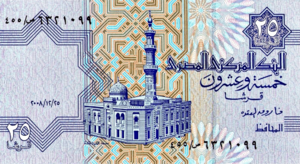 |
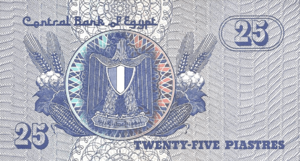 |
25 PT | 130 × 70 | Blue | Ayesha mosque | Coat of arms of Egypt | 1985 |
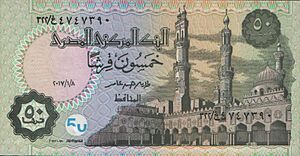 |
 |
50 PT | 135 × 70 | Brown/yellow-green | Al-Azhar Mosque | Ramesses II | 1985 |
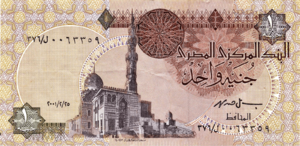 |
 |
£1 | 140 × 70 | Beige | Mosque and mausoleum of Qaitbay | Abu Simbel temples | 1978 |
 |
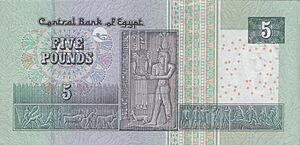 |
£5 | 145 × 70 | Bluish-green | Mosque of Ibn Tulun | A Pharaonic engraving of Hapi (god of the annual flooding of the Nile) offering bounties. | 1981 |
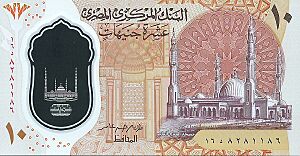 |
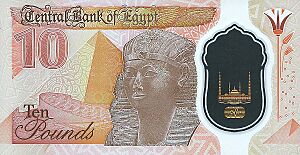 |
£10 | 132 × 69 | Orange | Al-Fattah Al-Aleem Mosque | Hatshepsut | 2022 |
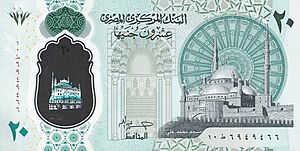 |
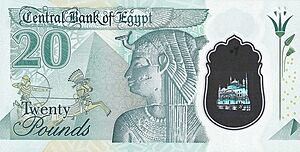 |
£20 | 137 × 69 | Mint Green | Mosque of Muhammad Ali | A Pharaonic war chariot and Queen Cleopatra | 2023 |
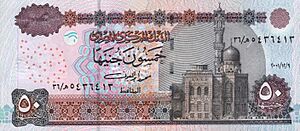 |
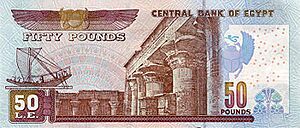 |
£50 | 160 × 70 | Brownish-red | Abu Hurayba Mosque
(Qijmas al-Ishaqi Mosque) |
Temple of Edfu | 1993 |
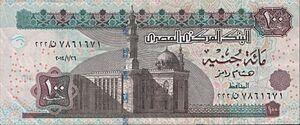 |
 |
£100 | 165 × 70 | Cyan | Sultan Hassan Mosque | Great Sphinx of Giza | 1994 |
 |
 |
£200 | 165 × 72 | Olive | Mosque of Qani-Bay | The Seated Scribe | 2007 |
Exchange Rates
The value of the Egyptian pound changes compared to other currencies like the British pound sterling and the US dollar. This is called the exchange rate.
Egyptian Pound vs. British Pound
This table shows how many Egyptian pounds you would get for one British pound sterling over time:
| Date | Official rate |
|---|---|
| 1885 to 1949 | E£0.975 |
| 2008 | E£10.0775 |
| 2009 | E£8.50 |
| 2012 | E£9.68 |
| 2014 | E£11.97 to E£12.03 |
| 2016 | E£12.60 to E£21.21 |
| 2017 | E£20.00 |
| 2020 | E£20.00 |
| 2022 | E£29.90 as of the end of the year |
| 2023 | E£39.31 as of November 29 |
| 2024 | E£59.52 |
Egyptian Pound vs. US Dollar
This table shows how many Egyptian pounds (or piastres before 1834) you would get for one US$:
| Date | Official rate |
|---|---|
| 1789 to 1799 | E£0.03 (3 PT) |
| 1800 to 1824 | E£0.06 (6 PT) |
| 1825 to 1884 | E£0.14 (14 PT) |
| 1885 to 1939 | E£0.20 |
| 1940 to 1949 | E£0.25 |
| 1950 to 1967 | E£0.36 |
| 1968 to 1978 | E£0.40 |
| 1979 to 1988 | E£0.60 |
| 1989 | E£0.83 |
| 1990 | E£1.50 |
| 1991 | E£3.00 |
| 1992 | E£3.33 |
| 1993 to 1998 | E£3.39 |
| 1999 | E£3.40 |
| 2000 | E£3.42 to E£3.75 |
| 2001 | E£3.75 to E£4.50 |
| 2002 | E£4.50 to E£4.62 |
| 2003 | E£4.82 to E£6.25 |
| 2004 | E£6.13 to E£6.28 |
| 2005 to 2006 | E£5.75 |
| 2007 | E£5.640 to E£5.50 |
| 2008 | E£5.50 to E£5.29 |
| 2009 | E£5.75 |
| 2010 | E£5.80 |
| 2011 | E£5.95 |
| 2012 | E£6.36 |
| 2013 | E£6.50 to E£6.96 |
| 2014 | E£6.95 to E£7.15 |
| 2015 | E£7.15 to E£11.00 |
| 2016 | E£15.00 to E£18.00 |
| 2017 | E£17.70 to E£17.83 |
| 2018 | E£17.69 to E£17.89 |
| 2019 | E£17.89 to E£15.99 |
| 2020 | E£16.04 to E£15.79 |
| 2021 | E£15.82 to E£15.71 |
| 2022 | E£15.72 to E£24.70 |
| 2023 | E£24.75 to E£30.95 parallel rate up to E£53 |
| 2024 | E£47.46 |
See also
- Economy of Egypt
- Economy of Africa
- Sudanese pound
| Current EGP exchange rates | |
|---|---|
| From Google Finance: | AUD CAD CHF EUR GBP HKD JPY USD ILS JOD TRY |
| From Yahoo! Finance: | AUD CAD CHF EUR GBP HKD JPY USD ILS JOD TRY |
| From XE.com: | AUD CAD CHF EUR GBP HKD JPY USD ILS JOD TRY |
| From OANDA: | AUD CAD CHF EUR GBP HKD JPY USD ILS JOD TRY |
| From fxtop.com: | AUD CAD CHF EUR GBP HKD JPY USD ILS JOD TRY |


